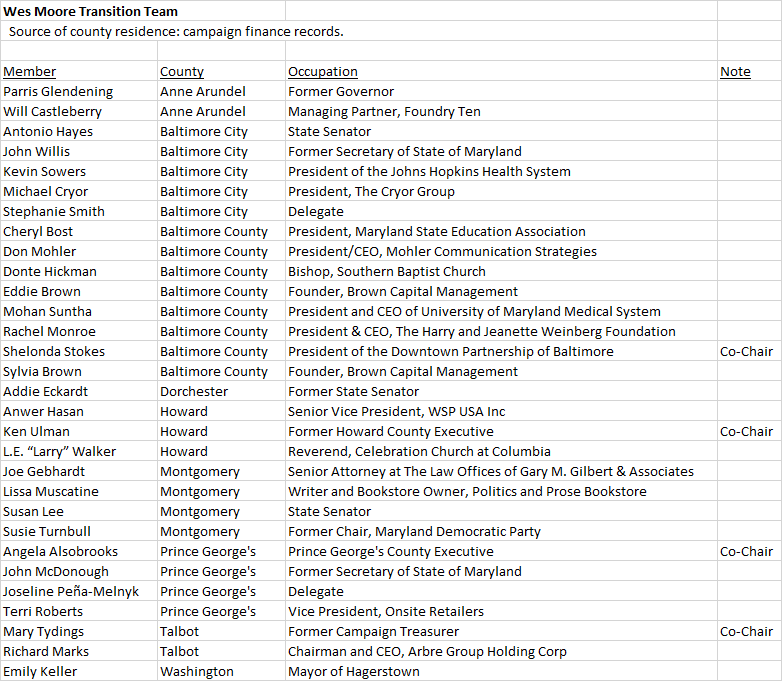By Adam Pagnucco.
Here is something incoming Governor Wes Moore is going to learn in his first elected job: in Maryland, geography is everything. It relates to race, politics, culture, climate, dialect and even (perhaps especially) food. Former Governor Martin O’Malley knew this, endlessly talking about “One Maryland” while levying taxes disproportionately on some parts of the state (like MoCo) to benefit others. Soon-to-be former Governor Larry Hogan knows this as he emphasized Western Maryland and the Eastern Shore while canceling Baltimore’s Red Line in service of the GOP’s narrative of the alleged “War on Rural Maryland.” Former General Assembly presiding officers Mike Miller and Mike Busch considered geography on committee assignments, budget, bond bills and almost everything else they did. Now Moore shows his hand through the appointment of his transition team.
Using campaign finance records, I identified the residence of each transition team member. The geography of the team reveals the incoming Moore administration’s first instincts on how to prioritize Maryland’s various competing fiefdoms.

The first thing one notices is that nearly half of the seats – 13 of 30 – are held by residents of Baltimore City and Baltimore County. That fits with Moore’s primary election performance, in which he ran up substantial margins in those places over Tom Perez and Peter Franchot. Nicely played, Governor-elect.
Next up is MoCo, which is much bigger than either Baltimore City or Baltimore County and gets just four seats. MoCo should not be surprised. We overwhelmingly voted for Perez in the primary and most of our elected officials who endorsed in the primary, including County Executive Marc Elrich, also supported Perez. I am a bit puzzled as to why Prince George’s did not get more representation but at least their county executive is a co-chair.
Then there is the rest of the state. Anne Arundel gets two seats but that comes with an asterisk. Former Governor Parris Glendening may live near Chesapeake Harbour now, but he is a former Prince George’s County Executive and is more associated with that jurisdiction than his current home. Several other sizeable jurisdictions – Carroll, Cecil, Frederick, Harford, Wicomico – are shut out. Southern Maryland has no seats. Western Maryland has one. Political types from all these places are going to take notice.
The most surprising element of this list is the treatment of Anne Arundel and Frederick. Anne Arundel just surpassed Baltimore City as the fourth-biggest jurisdiction in Maryland and is currently the site of a fiercely contested county executive race, a situation that is destined to repeat in the future. If Democratic incumbent Steuart Pittman wins, how is he supposed to explain a lack of participation in the Moore administration to his constituents? Frederick County has been a purple jurisdiction in which Republicans came close to winning the county executive seat this year. How is Moore supposed to bring them back into the fold if they are not represented in his administration? It’s one thing to neglect MoCo, which regards parochialism as beneath it, but it’s against Moore’s own self-interest to basically exclude jurisdictions like Anne Arundel and Frederick which could potentially spawn opponents in the next election.
It’s still early in the history of the Moore administration – REALLY early – so of course things can change. But consider the above list along with the residences of Senate President Bill Ferguson (Baltimore City) and Speaker of the House Adrienne Jones (Baltimore County) and it’s hard to escape this conclusion:
Baltimore City and Baltimore County are in the catbird seat. The rest of us are in the bleachers.
